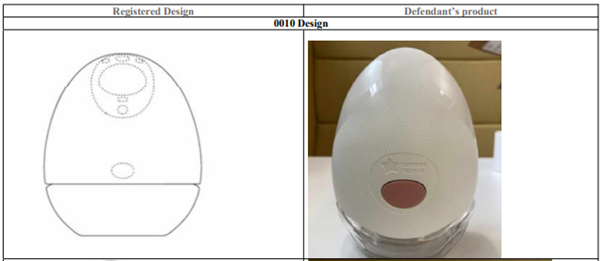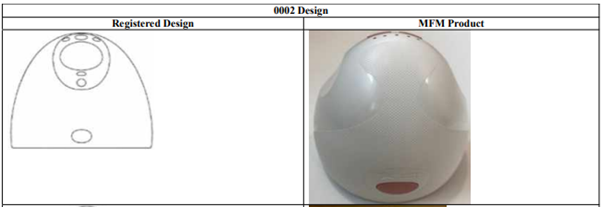Design Piracy or Functional Necessity: Court Rules on Breast Pump Battle in Chiaro Technology Limited v Mayborn (UK) Limited
The Claimant, Chiaro Technology Limited (“Chiaro”), is the owner of a number of registered designs of which several are incorporated into its product the ‘Elvie’, a wearable breast pump. Chiaro alleged that the Defendant, Mayborn UK Limited (“Mayborn”) seller of the ‘Made for Me’ wearable breast pump under the Tommee Tippee brand had infringed these designs by virtue of the sale of the Made for Me product (the “Mayborn Product”).
Sir Anthony Mann ruled in favour of Mayborn in the High Court, finding no infringement of any of Chiaro’s three registered designs by the Mayborn Product.
The judgment includes images which put the registered designs and photographs of the Mayborn Product side by side at Annex 1. A few of those images have been reproduced below directly from the approved judgment.
Background
The legal dispute between Chiaro and Mayborn centred around three registered designs. The 0010 design - the design of the pump as a whole, the 0002 design - the front housing of the design alone and the 0003 design - the milk collection vessel which sits at the bottom of the design. In coming to its decision on infringement, the Court considered section 7(1) of the Registered Designs Act 1949 (the “Act”) including section 1C(1) of the Act which figured heavily in this case.
Infringement Assessment
The test in section 7(1) of the Act as to whether the Mayborn Product was infringing Chiaro’s registered designs was whether, in the eye of the informed user, the Mayborn Product “does not produce…a different overall impression”. In getting to this point and in particular the assessment of the “overall impression”, the Judge considered Marks and Spencer v Aldi [2023] EWHC (IPEC) (“M&S v Aldi”) for guidance. This led the Judge to decide the sector of the products in which the designs are intended to incorporate or to which they are intended to belong to; the overall impression on the informed user; and the designer’s degree of freedom in developing a design before he went on to consider section 7(1) of the Act.
The notional key person who has to carry out the comparison exercise is the “informed user”, in this case the parties considered this type of user to be a nursing mother or wet nurse. The Judge added that:
“[s]uch a user would have a consumer’s view of the prior art, that is to say the other electrical pump products on the market, because she would be likely to try to understand the products which are available. She would apply a consumer’s eye, rather than a designer’s eye, but would generally be interested in general terms in the features that each product presented, in both operational and aesthetic terms. It would not be impractical for her to see the whole or most of the designs on the market because she would be able to get easy access to those designs, or material designs, via the internet or in retail shops” (para 25).
Additionally, the Judge turned to the application of sub-section 1C(1) of the Act, which states “[a] right in a registered design shall not subsist in features of appearance of a product which are solely dictated by the product’s technical function” before applying the section 7(1) test for each of the designs. The Judge was conscious that the informed user has to exclude facets of the design which are solely dictated by the product’s technical function.
The 0010 design
The Judge agreed that the shape of the outer (anterior) surface was not aesthetic but rather solely dictated by the device’s function of having to achieve co-operation with the shape and support of the bra, these features of the design had to be removed from consideration. The Judge went on to conclude that the Mayborn Product would create an overall different impression in the eye of the informed user.

Image taken from approved judgment dated 5 October 2023.
The 0002 design
This design was particular to the housing without the milk collection vessel and the breast shield. The Judge found, just as with the 0010 design, that the main curved shape was to be excluded due to its functional use. Also, that differences observed were sufficient to create a significantly different impression to the informed user.

Image taken from approved judgment dated 5 October 2023.
The 0003 design
With the 0003 design - the milk collection vessel which sits at the bottom of the design, the Judge found three of its features to be technical and thus part of the excluded function. These were, first, the location of the milk collection vessel being below the pump which was alleged to be a technical feature as gravity rather than the pump leads the milk to the collection point. The Judge did not think it was appropriate to consider this aspect of the design separately from the shape, and that it should be considered with the front curved aspect. Thus the Judge held that the positioning of the milk collection vessel was part of the excluded function. Second, the flat bottom, as it allowed for the unit to be placed on a flat surface without spilling, and third, the transparency of the milk collection vessel as it allowed the user to see the level of milk in the vessel.
The main differences highlighted by the Judge revolved around the circular hole at the top which connects to the pump unit and what the Judge described as “shoulders” which stemmed from that aperture. Considering these, the Judge took the view that the Mayborn Product would produce a different overall impression in the eye of the informed user.

Image taken from approved judgment dated 5 October 2023.
Comment
Overall, this case serves as a reminder that design protection is not absolute and that functional considerations play a significant role in determining the scope of protection. It emphasises the need to carefully consider functional constraints when seeking design protection and highlights that design features dictated by technical function are not protected by registered designs, even if they contribute to the overall appearance.
The full decision can be read here.

